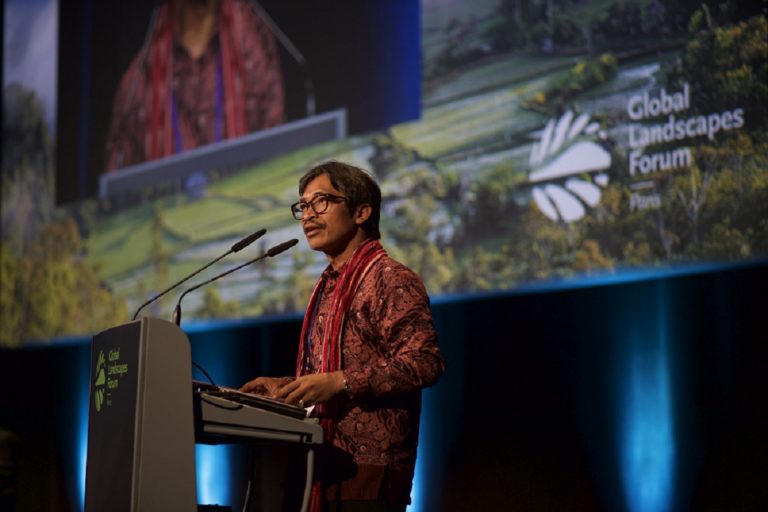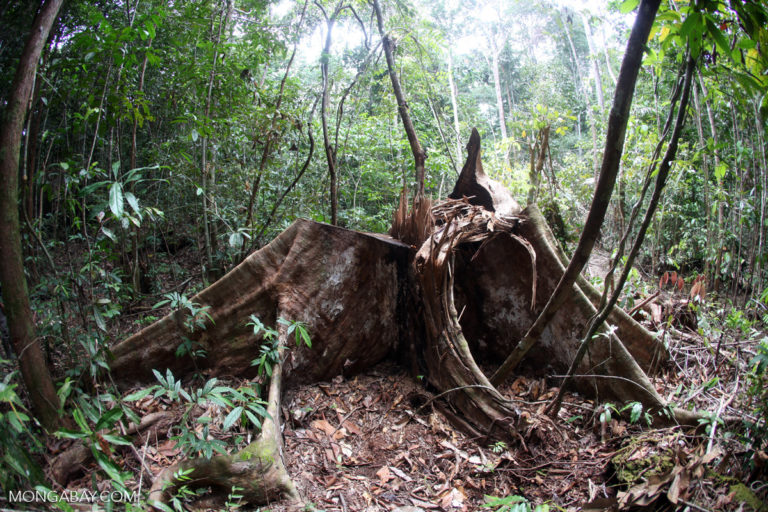- The Indigenous Peoples Alliance of the Archipelago holds its congress once every five years. The next one will take place this week in Tanjung Gusta village on the island of Sumatra.
- The Southeast Asian country is one of the planet’s most ethnically diverse, with hundreds of different languages spoken within its borders.
- After 10 years at the organization’s helm, Abdon Nababan will yield his position to someone new.
This week in Sumatra at a rare congress of the world’s largest indigenous peoples alliance, thousands of tribal representatives from every corner of Indonesia will gather to determine the future of their movement. A new national leadership will be chosen, and Abdon Nababan, one of the group’s most instrumental characters since its founding nearly two decades ago, will finally step away.
The Batak man from near North Sumatra’s giant Lake Toba has amassed a substantial resume. Since his election as head of the Indigenous Peoples Alliance of the Archipelago (AMAN) in 2007, Nababan and his team have won a court battle that freed all customary forests from state control, mapped an area of indigenous territory the size of South Carolina, and successfully prodded the government to recognize the rights of nine communities to the lands they call home. They have raised the cachet of indigenous peoples in a society long run by a military dictatorship that seemed to want nothing to do with them, save for exploiting their natural wealth. This week, Joko Widodo will become the first president to deliver a speech at an AMAN congress, an emblem of how far the organization has come under Nababan’s watch.
Mongabay spoke with Nababan ahead of the congress about the strategies he has employed, the qualities needed to lead AMAN and more.

AN INTERVIEW WITH ABDON NABABAN
Mongabay: What is AMAN’s ultimate goal? To secure for every one of Indonesia’s indigenous groups the legal right to use and own the forests they live in?
Abdon Nababan: I always start with myself. I began in this work from the environmental side. So that’s my main goal. But I know that the easiest, cheapest, most logical way to do that is to support indigenous peoples. I was working hard as an environmental activist but getting no results. So I looked back to my community.
After university, I joined Walhi [Indonesia’s largest environmental pressure group] and became coordinator for forest investigations. I saw that the best forest we have is not in the national parks; it is the forest that is protected by indigenous peoples. And this good forest provides everything to those who protect it.
I was involved in campaigns to mobilize action against [PT Inti Indorayon Utama, a paper milling firm in North Sumatra]. Part of the area was my ancestral land. So this movement became very personal. This is not somebody else’s problem; this is my community’s problem, my brother and sister’s problem. I realized we had to bring culture to the core of the environmental movement.
Mongabay: You played a lead role in organizing the first indigenous peoples congress, held in the late 1990s as Suharto’s military dictatorship collapsed. Was it a challenge to unite hundreds of communities under a single platform?
Nababan: The most important principle of AMAN is to respect differences, to bridge the gap between majority and minority. In AMAN, big ethnic groups have the same rights as small ones.
Our platform called for an end to the militarization of indigenous lands. For company licenses to be revoked. For no more domination by imported religions. To stop transmigration. We wanted to dissolve the religion ministry and the transmigration ministry. When we brought all that together, people felt like this is our problem.
Some said we should make it more moderate. I said no — for the new organization, we need really strong positions. How we play with that, that’s strategy.

Mongabay: AMAN’s initial stance was totally adversarial. Fast forward to the 2012 congress, where government officials attended for the first time. This time around the president himself will deliver a speech. What happened to bring that about?
Nababan: I’m good at nurturing relations with good people. During the SBY era, I identified people inside, like Pak Kuntoro [Mangkusubroto, head of a now-defunct presidential unit on development oversight]. We could talk frankly about this movement; I trusted him. It wasn’t because ideologically we were similar. He came from the extractive industry; he was the minister of mining. And he clearly believes in the free market. But he has a good heart. I started from there.
If I know good people, I try not to put them on that black side. I can be really critical of government while maintaining good relations with people. To assess our enemy and ourselves is very important. That’s the quality for leader of AMAN.

Mongabay: Is it easy to approach government officials? Are they open to talking about these issues?
Nababan: Not in their office. But if you know their family — maybe he or she is an indigenous person, and then you can learn about his group, and bring him back to his identity. Two or three years later, he or she will be your friend. Government officials are educated to be the enemy of indigenous peoples, but in their daily life they are doing indigenous things. Split personality, you know? My role is to bring him to real life. ‘Every year you go home to your village; what are you doing in your village actually?’ It’s about self-identification. You have to make them understand, ‘This is about me. This is about my forest, this is about my land, this is about my water.’ That ability is destroyed by school. So it should be restored. Officials are some of the most educated people, so they’re a little farther away. The more education you get, it requires greater effort.
If you’re not strategic, you will spend energy on small small things. We have very limited resources. No money. Even to have new activists to work with us we have to have training, it’s very expensive. That’s why the situation forced me to be strategic.
Mongabay: How have the strategies employed by AMAN evolved over the years?
Nababan: If you see Indonesia, it’s a very huge country, with very diverse cultures and ecosystems. So the vision is about local sovereignty, how peoples can regulate and govern their own lives. Of course, indigenous peoples will have a different vision for that.
The first strategy is how to make this movement feasible. How to make indigenous peoples feasible. We bring something different, from our daily life. That’s the meaning of the movement. If you are not feasible, you are not subject to anything. To say that you exist. And people can see you. Through mobilizations, actions, campaigns, demonstrations, blockades.
And of course to do that you have to ask a lot of people to have new awareness about their identity as indigenous peoples. So education is the second thing, to educate more and more people to join the club. And then the third is advocacy. How to change your environment. The outside. The state. The nation. The World Bank. The government. Everything. In the end, we want to run the country based on our knowledge, our values.

Mongabay: Some say the government should maybe think twice before letting indigenous communities own their lands and forests, because they might sell them on to investors. Conservation biologist Erik Meijaard wrote in 2014: “What will communities or individual people do when they can get legal title to what was previously state-owned land?….I would think many will immediately sell their land to whoever is the highest bidder: likely industrial-scale companies investing in oil palm, pulp and paper, rubber, and mining.” Your response?
Nababan: I don’t need to respond, because from what I learn about him, he doesn’t understand the history of colonization of indigenous peoples, the history of destruction of indigenous peoples. If he only looks at the current situation, he’s right. It happens. Because he visited the frustrated peoples with no hope. Maybe there’s no more forest. So that’s why I didn’t really have to say something about it. Because we can — with AMAN, with this big organization — we can show more cases the better, the best practices than what he found on the ground.
Mongabay: Do you hear this from the government?
Nababan: Of course. But we say, how many hectares? I can show you that a million hectares are still good forest because it’s protected by indigenous peoples. Show me Erik’s findings, how many hectares? Because from our participatory mapping we can show, this forest is still the best forest we have. Because their indigenous system still works. So the problem right now with many indigenous peoples, they are indigenous peoples, but their indigenous systems already broke. So we say don’t victimize the victim. Let’s empower their system. It’s not their fault. They are the victim of government policy — the policy to always hand out concessions to companies.
The problem is there is no recognition, so it becomes nebulous, and then the elites try to sell the land. You know how their land market works. Because there’s no clear legality. Just put in the decree [that gives an indigenous community title to its land] that they cannot sell it. That’s the basic value.
Mongabay: What about development in general?
Nababan: We have no problem with development. The important thing is who controls the development: indigenous values or the greedy capitalist from Washington? If the community controls the model of development, I think no problems. They can grow themselves with development. But now development eats them. Because development is controlled by someone. So it’s a matter of what development you mean.

Mongabay: What qualities should AMAN’s next secretary general possess?
Nababan: I think for next leadership, they don’t need like me. AMAN has come a long way. In the past if you say indigenous peoples rights, you are labeled anti-development, or communist, or if you are in Papua you are separatist. Today you can talk about indigenous peoples wherever you want.
The challenge for AMAN is how to prevent the military from taking power again. They are still there, ready to take over Jokowi’s government. Because this government is too transparent. Military and also the conglomerates don’t like that. So that’s why the quality for leadership for AMAN for the next is like that, how to keep the civil society and the political party stronger, to consolidate the democracy against these military radical things. Not really talk about indigenous peoples but how to protect this from militarization, radicalization. They must have the capacity to build political alliances.
Mongabay: What’s next for you?
Nababan: I don’t know. My focus is on strengthening the local structure. So I need more time to travel. I’m really concerned with Papua. My heart is there. Because there is a civilization gap. And we have to have something to bring there, to bridge the gap. If not, no future for Papua. The militarization is still there. Papua is an indigenous island. It’s really genocide happening.